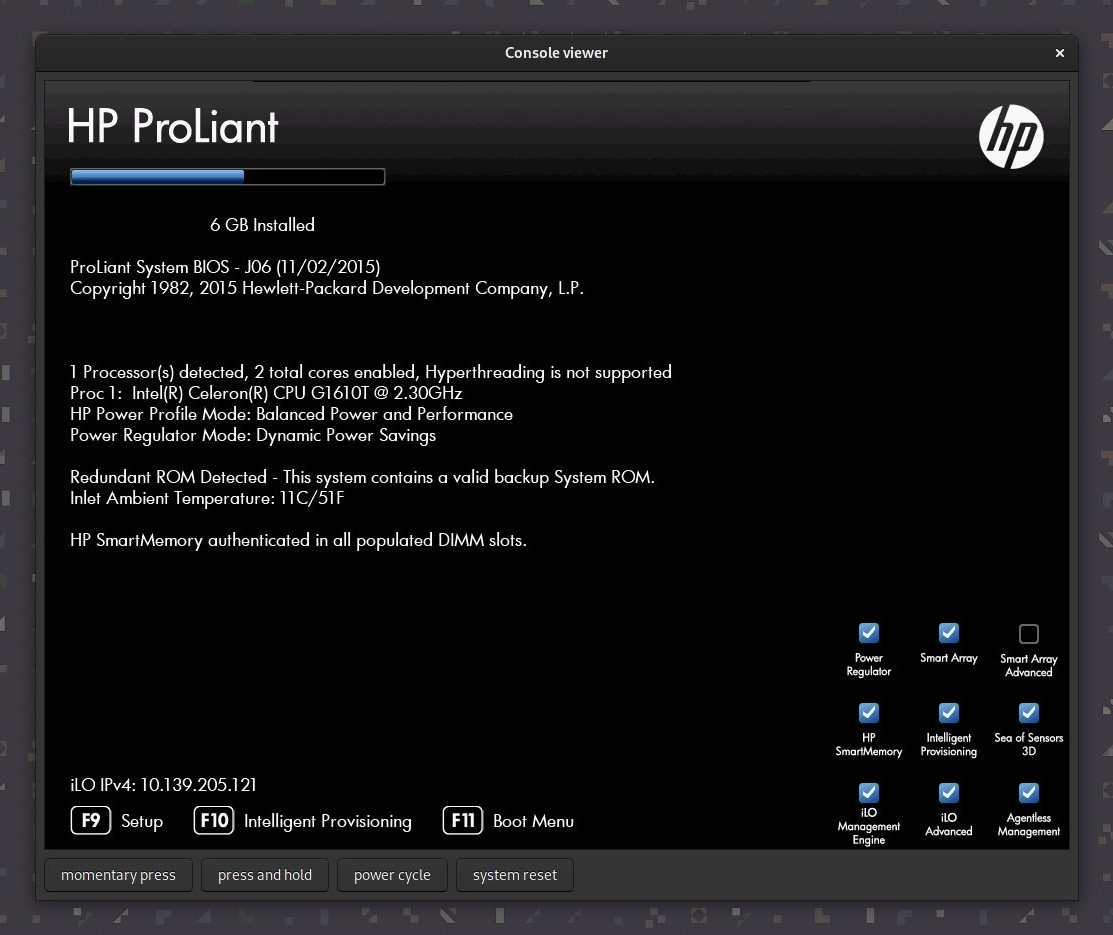ilo-protocol v1.0.0-beta
ilo-protocol
Node.js module to interact with iLO (Integrated Lights-Out) modules in HPE servers. iLO 4 v2.55 (and possibly other versions) are supported.
npm install ilo-protocolThe focus is on implementing the remote console protocol, which allows you to manage the server as if you were sitting at the KVM. You can:
- See the server's screen
- Use the keyboard / mouse
- Virtual media: mount a file / device from your computer that the server will see as a real SCSI device (hard drive, CDROM or floppy disk)
- Press the power button, trigger a power cycle or system reset
In addition to implementing the protocol itself, the repository also comes with a fully-functional client in its examples, see examples.
Protocol overview
Initiation
First, the /json/rc-info endpoint in the HTTPS webserver is called.
Like the whole API, it's authenticated with a 16-byte session key.
It returns, among other things:
- the network ports to connect to
- remote console port
- virtual media port
- the main encryption key to use for the session
- list of supported extra protocol features
From there the protocol itself starts. The client opens a TCP connection to the remote console port. It initiates a handshake to negotiate a remote console session, where the client authenticates to the server by sending the session key mentioned before, optionally (sort of) XOR-ed with the encryption key.
The server may reject the session because of several reasons (no license, wrong authentication, no free sessions, etc.), or it may accept it. If accepted, but another session is in progress, busy negotiation occurs. There's the option to share the session with the other user, or seize it from them. Seizing requires confirmation from the other user.
After that, another connection is opened to the same port, but a slightly different handshake is used which negotiates a command session. That session doesn't seem to be of much use so we'll focus on the remote console session from now on.
Server data (video stream)
TODO: document protocol
Client data (user input)
TODO: document protocol
Encryption
Once the handshake is over, the server may choose to switch the remote console session into RC4, AES128 or AES256 encryption. The encryption only applies to the remote console session, to both server and client data. Other sessions, like the command session or virtual media traffic (data read / written) are not encrypted, at least in the implemented version.
The ciphers are always used as stream ciphers, i.e. block cyphers are used in OFB mode.
Virtual media
TODO: document protocol
Usage
This library only has some dependency on Node.js APIs (streams and crypto) but is designed to be relatively easy to run in the browser.
Only the protocol itself is implemented; the user must handle
decoded data, render it to the screen, listen to user input, and even
network and filesystem I/O. The only exception is the rest module,
which uses Got to make HTTPS
requests.
The modules are structured as follows (internal APIs omitted):
rc/: implements the remote console sessionrc/handshake: initial handshake (authentication, busy negotiation)rc/telnet: outer layer that kicks in after the handshake (processes client & server data, mostly encryption)rc/video: decodes the video stream fromtelnetrc/command: formats commands sent to the server, both in the handshake and afterwards (throughtelnet)
vm/: implements the virtual media sessionsvm/handshake: initial handshakevm/scsi: protocol implementation, simulates SCSI device behavior (for now, only CDROM is supported)
Examples
The examples directory contains many examples of using the library.
app.ts

It's a completely functional GTK-based client, and it shows usage of (almost)
all protocol features.
To try it out:
npm install
$(npm bin)/ts-node examples/app.ts <arguments>Note: It's currently hardcoded to assume Linux (evdev) keycodes, so keyboard input probably won't work correctly on other OSes, or ancient Linux installs.
Note: This example depends on romgrk/node-gtk#252,
package.json already installs that branch from my repo, but you
need to do npm explore node-gtk -- npm run build:full after
npm install to make sure it picks up the changes.
vm_cdrom.ts
Simple program that mounts the supplied file as a CDROM device.
To try it out:
npm install
$(npm bin)/ts-node examples/vm_cdrom.ts <arguments>4 years ago